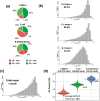Systematic and stochastic influences on the performance of the MinION nanopore sequencer across a range of nucleotide bias
- PMID: 29453452
- PMCID: PMC5816649
- DOI: 10.1038/s41598-018-21484-w
Systematic and stochastic influences on the performance of the MinION nanopore sequencer across a range of nucleotide bias
Abstract
Emerging sequencing technologies are allowing us to characterize environmental, clinical and laboratory samples with increasing speed and detail, including real-time analysis and interpretation of data. One example of this is being able to rapidly and accurately detect a wide range of pathogenic organisms, both in the clinic and the field. Genomes can have radically different GC content however, such that accurate sequence analysis can be challenging depending upon the technology used. Here, we have characterized the performance of the Oxford MinION nanopore sequencer for detection and evaluation of organisms with a range of genomic nucleotide bias. We have diagnosed the quality of base-calling across individual reads and discovered that the position within the read affects base-calling and quality scores. Finally, we have evaluated the performance of the current state-of-the-art neural network-based MinION basecaller, characterizing its behavior with respect to systemic errors as well as context- and sequence-specific errors. Overall, we present a detailed characterization the capabilities of the MinION in terms of generating high-accuracy sequence data from genomes with a wide range of nucleotide content. This study provides a framework for designing the appropriate experiments that are the likely to lead to accurate and rapid field-forward diagnostics.
Conflict of interest statement
The authors declare no competing interests.
Figures








Similar articles
-
Evaluation of strategies for the assembly of diverse bacterial genomes using MinION long-read sequencing.BMC Genomics. 2019 Jan 9;20(1):23. doi: 10.1186/s12864-018-5381-7. BMC Genomics. 2019. PMID: 30626323 Free PMC article.
-
Characterization of MinION nanopore data for resequencing analyses.Brief Bioinform. 2017 Nov 1;18(6):940-953. doi: 10.1093/bib/bbw077. Brief Bioinform. 2017. PMID: 27559152
-
Benchmarking of de novo assembly algorithms for Nanopore data reveals optimal performance of OLC approaches.BMC Genomics. 2016 Aug 22;17 Suppl 7(Suppl 7):507. doi: 10.1186/s12864-016-2895-8. BMC Genomics. 2016. PMID: 27556636 Free PMC article.
-
On-Site MinION Sequencing.Adv Exp Med Biol. 2019;1129:143-150. doi: 10.1007/978-981-13-6037-4_10. Adv Exp Med Biol. 2019. PMID: 30968366 Review.
-
The Future of Livestock Management: A Review of Real-Time Portable Sequencing Applied to Livestock.Genes (Basel). 2020 Dec 9;11(12):1478. doi: 10.3390/genes11121478. Genes (Basel). 2020. PMID: 33317066 Free PMC article. Review.
Cited by
-
Genomic architecture of 5S rDNA cluster and its variations within and between species.BMC Genomics. 2022 Mar 27;23(1):238. doi: 10.1186/s12864-022-08476-x. BMC Genomics. 2022. PMID: 35346033 Free PMC article.
-
Long reads: their purpose and place.Hum Mol Genet. 2018 Aug 1;27(R2):R234-R241. doi: 10.1093/hmg/ddy177. Hum Mol Genet. 2018. PMID: 29767702 Free PMC article. Review.
-
NanoHIV: A Bioinformatics Pipeline for Producing Accurate, Near Full-Length HIV Proviral Genomes Sequenced Using the Oxford Nanopore Technology.Cells. 2021 Sep 28;10(10):2577. doi: 10.3390/cells10102577. Cells. 2021. PMID: 34685559 Free PMC article.
-
DNA methylation in monozygotic twins discordant for acute lymphoblastic leukemia: a case report and systematic review.Clin Epigenetics. 2025 Jun 6;17(1):94. doi: 10.1186/s13148-025-01906-z. Clin Epigenetics. 2025. PMID: 40481591 Free PMC article. Review.
-
Metagenomic surveillance for bacterial tick-borne pathogens using nanopore adaptive sampling.Sci Rep. 2023 Jul 7;13(1):10991. doi: 10.1038/s41598-023-37134-9. Sci Rep. 2023. PMID: 37419899 Free PMC article.
References
Publication types
MeSH terms
Substances
LinkOut - more resources
Full Text Sources
Other Literature Sources
Miscellaneous

